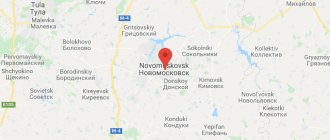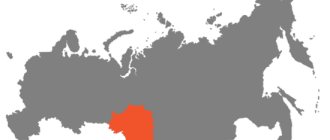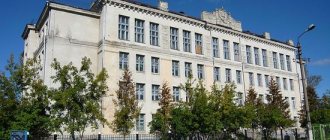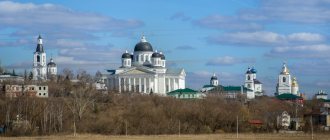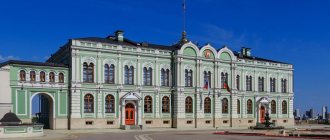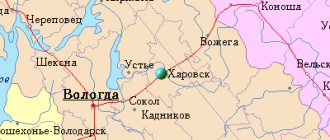This term has other meanings, see Krasnoarmeysk.
| City Krasnoarmeysk Coat of arms |
| A country | Russia, Russia |
| Subject of the federation | Saratov regionSaratov region |
| Municipal district | Krasnoarmeisky |
| urban settlement | Municipal entity Krasnoarmeysk |
| Coordinates | 51°01′00″ n. w. 45°42′00″ E. d. / 51.01667° n. w. 45.70000° E. d. / 51.01667; 45.70000 (G) [www.openstreetmap.org/?mlat=51.01667&mlon=45.70000&zoom=12 (O)] (Z)Coordinates: 51°01′00″ N. w. 45°42′00″ E. d. / 51.01667° n. w. 45.70000° E. d. / 51.01667; 45.70000 (G) [www.openstreetmap.org/?mlat=51.01667&mlon=45.70000&zoom=12 (O)] (I) |
| Based | in 1765 |
| Former names | until 1925 — Naked Karamysh until 1942 - |
| City with | 1918 |
| Center height | 210 |
| Population | ↘23,468[1] people (2016) |
| Names of residents | Red Army soldiers, Red Army soldier |
| Timezone | UTC+3 |
| Telephone code | +7 84550 |
| Postcode | 412800 |
| Vehicle code | 64, 164 |
| OKATO code | [classif.spb.ru/classificators/view/okt.php?st=A&kr=1&kod=63418 63 418] |
| Krasnoarmeysk Moscow |
| Saratov Krasnoarmeysk |
K: Settlements founded in 1765
Krasnoarmeysk
- a city in Russia, the administrative center of the Krasnoarmeysky district of the Saratov region.
Population - 23,468[1] people. (2016).
Story
Founded in 1765 as a colony of German settlers called Balzer
(Balzer).
During the first 2 years, only about 90 families settled in the colony. These were immigrants from Hesse, Palatinate, Isenburg and other German lands and cities. According to the 1768 census, there were 377 people in the colony. The first headman (forestager) of the colony was a peasant from Hesse, Balzer Bartuli, whose name was taken for the name of the colony itself. However, according to the decree of February 26, 1768 “On the names of German colonies”, the colony received the official name Naked Karamysh
[3], where Karamysh is the Turkic word for “muddy, muddy”, and the definition naked indicated the location in a treeless steppe area.
In the middle of the 19th century, it was officially called Naked Karamysh (Balzer).
In 1918, the colony became the center of the Golo-Karamysh district
the newly formed Labor Commune of the Volga Germans, since 1922 - the center of the Golo-Karamysh (Baltser) canton of the Autonomous Soviet Socialist Republic of the Volga Germans.
In 1925, the Naked Karamysh
officially reorganized as the city
of Balzer
.
The city was one of the centers for learning weaving. The training was conducted in a training and demonstration weaving workshop. Upon graduation from this educational institution, graduates were assigned to weaving artels.
On September 7, 1941, after the liquidation of the Autonomous Soviet Socialist Republic of the Volga Germans, the city became the administrative center of the Baltser district as part of the Saratov region[4].
In May 1942, the city of Balzer
was renamed
Krasnoarmeysk
in honor of the Red Army.
On February 1, 1963, the city of Krasnoarmeysk was classified as a city of regional subordination[5].
Krasnoarmeysk
(Saratov region)
OKATO code:
63222501
Founded:
1766
City since:
1918 City of district subordination (Krasnoarmeysky district, Saratov region)
Center:
Krasnoarmeysky district
The city was formerly called:
| Naked Karamysh | 1926 | |
| Balzer | 1926 | 1942 |
| Telephone code (reference phone) | |
| 84550***** | 22-0-83 |
Deviation from Moscow time, hours:
1
Geographic latitude:
51°01′
Geographic longitude:
45°42′
Altitude above sea level, meters:
210 Sunrise and sunset times of the Sun and Moon in the city of Krasnoarmeysk
Industry
There are factories in the city: weaving (closed), sewing, knitting (closed); factories: mechanical (closed), oil mill (closed), ceramic (until 2002 - brick). The ceramic (formerly brick) factory owns a narrow-gauge railway. It can be considered one of the main attractions of the city. This is the only narrow-gauge railway in the Saratov region; as of 2006, it operates a unique home-made locomotive that transports clay from the quarry to the processing workshop.
Coat of arms of the city of Krasnoarmeysk (1987 - 2004)
Coat of arms of Krasnoarmeysk: “The heraldic shield is divided into two parts, characterizing the historically established features of the city: northern (blue field) and southern (red field). On the top field there is a stylized image of a land meter - a symbol of industrial enterprises in the northern part of the city. At the bottom is a bobbin, a symbol of the oldest industry in the southern part of the city. The heraldic shield is bordered by a gold stripe, on the upper wider part is the word “Krasnoarmeysk”.
Author:
German Yakovlevich Demin.
Approved August 13, 1987
Date modified: 07/21/2021 11:07
Attractions
In the city there is a monument to the revolutionary V. T. Smolyaninov, a branch of the Museum of Local History.
Unique ancient houses made of red brick made of local clay - the recipes for the mortar of their masonry are still not known.
Children's summer recreation center in an oak grove - not far from the bank of the Volga River, on the site of the former count's estate
with the children’s favorite, stunning size and geometry, domed structure of the “Count” spring.
The width of the Volga River near the former merchant village of Zolotoe
(called barge haulers after the place of payment) reaches 19.6 kilometers when the Volzhskaya Hydroelectric Power Station dam is blocked.
- Evangelisch-lutherische Kirche Balzer Baujahr 1851 Foto ca 1931.jpg
Lutheran Church, built in the town of Baltser, Kamyshin district, Saratov province in 1851. Destroyed in the 20th century.
- Balzer Amtsgebaeude 2000.jpg
An administrative building built in Balzer in the 19th century.
- Balzer Textilfabrik 2000.jpg
Textile factory building built in the 19th century.
Krasnoarmeysk: the city of mosaic masonry
Until the middle of the last century, the Saratov region was also known as the territory of the Volga Germans. Since the time of Empress Catherine II, who invited the Germans to populate the deserted steppes of the lower Volga, the number of colonies has expanded and the number of their inhabitants has grown. By the time of the deportation in 1941, there were already about a million Volga Germans. Previously, we visited one of the most famous German colonies - Sarepta, now it is part of Volgograd.
In the Saratov region, one of the most famous colonies was Baltser, aka Pantsyr, aka Naked Karamysh, present-day Krasnoarmeysk. We went there to see if anything had survived from the former German colonies.
The mother colony of Balzer originated in 1765. In September, 11 families from the cities of Baden-Baden, Darmstadt, Isenburg, Kurpfalz and Switzerland arrived in the town on the banks of the Goly Karamysh River. The bulk of the settlers were from one region of Germany - Isenburg and Kurpfalz. The settlement was named after the first headman, Balzer Barnuli. The colony had this name for only three years, then it was renamed Naked Karamysh. The city became a Krasnoarmeisk city in 1942, when the Volga Germans had already been deported, and settlers from other regions of the USSR were settled here.
Over the course of a couple of centuries, the colonists managed to adapt well to the banks of the Volga. Thanks to their entrepreneurial spirit, the city became a real industrial center. By the revolution of 1917, in Goly Karamysh there were 23 sarpinka and 22 tanneries, an oil mill, a brewery, a power plant, and the trading house “Bender and Sons” operated. Horse-drawn carts, carding machines, winnowing machines and much more were made in the city.
What remains of the German colony today? Several brick buildings have been preserved and are in good condition. It is not difficult to recognize them - they are built using the brick mosaic technique. The walls are made of red and orange bricks. Construction materials were produced here. By the way, as they say, the secret of the mortar that was used to hold the bricks together has still not been figured out. Have you even tried?
German buildings have been preserved in the city center and are now used by various institutions. The most grandiose buildings by local standards are located on May 1st Street and they belonged to the same family - the Bender mansion and the Bender factory. All the Bender brothers - Egor, Yakov and Ivan - were entrepreneurs.
After the revolution, all the property of the merchants was requisitioned by the Soviet government. The factory building still houses knitting production. There is a social assistance center in the entrepreneur’s residential building.
On Lenin Street, 56, in a two-story building of German construction, today there are several institutions, including the editorial office of the regional newspaper “New Life”. In 1942, the Engels Machine Gun School was located in this building, which was located here until 1944. In front of the building in 2014, a small monument was erected in memory of the cadets who participated in the Great Patriotic War.
The central square of Krasnoarmeysk is Victory Square. On it is a traditional monument to the leader of the proletarian revolution. The sculpture of Lenin is a miniature of the monument in Saratov on Teatralnaya Square.
On the opposite side there is a memorial to soldiers who died in the Great Patriotic War and the Eternal Flame. The monument, authored by sculptor Shalva Zautashvili, was erected in 1975.
In the park behind the monument there are monuments to participants in local wars and liquidators of the Chernobyl nuclear power plant accident.
Nearby is a monument that evokes ambivalent feelings. The monument was erected to the soldiers of the special forces unit (CHON), who died in 1919-1921 while suppressing peasant riots. The monument is located above the mass grave in which the Red Army soldiers were buried. According to some reports, 30 people are buried here. In 1919, an uprising broke out in the city of Warnburg (now the village of Privalnoye). CHON members from Balzer came out to suppress the protest. Two detachments were formed in the city, commanded by the brothers Mikhail and Fyodor Wigandt. In Warnburg, 19 CHON members laid down their heads and were buried in one grave in the city cemetery. During the suppression of other riots, there were also those killed, they were buried next to their fallen comrades. According to some reports, in the grave lies the son of the merchant Andrei Bender, Robert, who fought for the Reds during the Civil War.
After a park was built on the site of the city cemetery in the 1920s, the mass grave was actually moved to the city center. In 1964, a monument was erected, the author of which was Saratov sculptor Georgy Epov. According to Soviet tradition, the opening of the monument was timed to coincide with November 7, the next anniversary of the October Revolution.
From the back of the monument, near the pedestal, a hole was exposed, covered with boards. It is possible that this is the covering of a mass grave of ChON members.
The city park is within walking distance from the monument. It has a children's playground and several exercise equipment. There are also monuments - six busts of Heroes of the Soviet Union, residents of the Krasnoarmeysky district. Next to them is a flat fountain, for some reason the water in it is greenish in color. Maybe this is the author's idea, or the water has become colored due to improper use of the fountain.
The local history museum in Krasnoarmeysk is located on Internatsionalnaya Street, 32. It is relatively young, it was opened in 1987 as a public museum of revolutionary, military and labor glory. Three years later it became a branch of the Saratov Regional Museum of Local Lore. In an old German house built at the beginning of the 20th century, several halls housed an exhibition traditional for such institutions. There is a small display case with stuffed animals and birds that live in the area.
One room tells about the life and everyday life of the German colony of Balzer. Much attention in the museum is paid to showing the development of weaving production in the city. As we wrote above, in Balzer there were more than two dozen factories that produced the famous sarpinka fabric.
In another room, exhibits tell about the events of the war years, the participation of area residents in hostilities and work on the home front.
It must be said that the exhibition is very archaic; the exhibits are in antediluvian glass cases. The museum clearly needs a good modernization.
The museum is open daily, except Mondays, from 09:00 to 17:00. Tickets are very inexpensive. For adults - 40 rubles, for children, students, pensioners, military personnel - 30 rubles. There is a separate fee for photography.
Next to the typical building of the regional palace of culture there is a small sculpture of an accordion player. Local residents said that this is a monument to a Red Army celebrity - the founder and leader of the Saratov harmonica ensemble “Naughty Bells” Vladimir Weiss. The team can be called a cultural brand of the Krasnoarmeysky region. Vladimir Weiss organized it in 1964, and now his son Alexander continues the business. The ensemble went on tour in several countries around the world - Czechoslovakia, Mozambique, East Germany. In 2014, “Naughty Bells” were participants in the cultural program of the Olympics in Sochi. However, now the monument is slightly peeling and needs restoration.
An excerpt characterizing Krasnoarmeysk (Saratov region)
“Yes, go, go, tell me to cook,” she said, pouring out. Boris quietly walked out the door and followed Natasha, the fat boy angrily ran after them, as if annoyed at the frustration that had occurred in his studies. Of the young people, not counting the countess's eldest daughter (who was four years older than her sister and already behaved like a grown-up) and the young lady's guest, Nikolai and Sonya's niece remained in the living room. Sonya was a thin, petite brunette with a soft gaze, shaded by long eyelashes, a thick black braid that wrapped around her head twice, and a yellowish tint to the skin on her face and especially on her bare, thin, but graceful, muscular arms and neck. With the smoothness of her movements, the softness and flexibility of her small limbs, and her somewhat cunning and reserved manner, she resembled a beautiful, but not yet fully formed kitten, which would become a lovely little cat. She apparently considered it decent to show participation in the general conversation with a smile; but against her will, from under her long thick eyelashes, she looked at her cousin [cousin] who was leaving for the army with such girlish passionate adoration that her smile could not deceive anyone for a moment, and it was clear that the cat sat down only to jump more energetically and play with your sauce as soon as they, like Boris and Natasha, get out of this living room. “Yes, ma chere,” said the old count, turning to his guest and pointing to his Nicholas. - His friend Boris was promoted to officer, and out of friendship he does not want to lag behind him; he leaves both the university and me as an old man: he goes into military service, ma chere. And his place in the archive was ready, and that was it. Is that friendship? - said the count questioningly. “But they say war has been declared,” said the guest. “They’ve been saying this for a long time,” said the count. “They’ll talk and talk again and leave it at that.” Ma chere, that’s friendship! - he repeated. - He is going to the hussars. The guest, not knowing what to say, shook her head. “Not out of friendship at all,” answered Nikolai, flushing and making excuses as if from a shameful slander against him. – Not friendship at all, but I just feel a calling to military service. He looked back at his cousin and the guest young lady: both looked at him with a smile of approval. “Today, Schubert, colonel of the Pavlograd Hussar Regiment, is dining with us. He was on vacation here and takes it with him. What to do? - said the count, shrugging his shoulders and speaking jokingly about the matter, which apparently cost him a lot of grief. “I already told you, daddy,” said the son, “that if you don’t want to let me go, I’ll stay.” But I know that I am not fit for anything except military service; “I’m not a diplomat, not an official, I don’t know how to hide what I feel,” he said, still looking with the coquetry of beautiful youth at Sonya and the guest young lady. The cat, glaring at him with her eyes, seemed every second ready to play and show all her cat nature. - Well, well, okay! - said the old count, - everything is getting hot. Bonaparte turned everyone’s heads; everyone thinks how he got from lieutenant to emperor. Well, God willing,” he added, not noticing the guest’s mocking smile. The big ones started talking about Bonaparte. Julie, Karagina’s daughter, turned to young Rostov: “What a pity that you weren’t at the Arkharovs’ on Thursday.” “I was bored without you,” she said, smiling tenderly at him. The flattered young man with a flirtatious smile of youth moved closer to her and entered into a separate conversation with the smiling Julie, not noticing at all that this involuntary smile of his was cutting the heart of the blushing and feignedly smiling Sonya with a knife of jealousy. “In the middle of the conversation, he looked back at her. Sonya looked at him passionately and embitteredly and, barely holding back the tears in her eyes and a feigned smile on her lips, she stood up and left the room. All Nikolai's animation disappeared. He waited for the first break in the conversation and with an upset face left the room to look for Sonya. – How the secrets of all these young people are sewn with white thread! - said Anna Mikhailovna, pointing to Nikolai coming out. “Cousinage dangereux voisinage,” she added. “Yes,” said the countess, after the ray of sunshine that had penetrated into the living room with this young generation had disappeared, and as if answering a question that no one had asked her, but which constantly occupied her. - How much suffering, how much anxiety has been endured in order to now rejoice in them! And now, really, there is more fear than joy. You're still afraid, you're still afraid! This is precisely the age at which there are so many dangers for both girls and boys. “Everything depends on upbringing,” said the guest. “Yes, your truth,” continued the Countess. “Until now, thank God, I have been a friend of my children and enjoy their complete trust,” said the countess, repeating the misconception of many parents who believe that their children have no secrets from them. “I know that I will always be the first confidente [confidant] of my daughters, and that Nikolenka, due to her ardent character, if she plays naughty (a boy cannot live without this), then everything is not like these St. Petersburg gentlemen. “Yes, nice, nice guys,” confirmed the count, who always resolved issues that confused him by finding everything nice. - Come on, I want to become a hussar! Yes, that's what you want, ma chere! “What a sweet creature your little one is,” said the guest. - Gunpowder! “Yes, gunpowder,” said the count. - It hit me! And what a voice: even though it’s my daughter, I’ll tell the truth, she will be a singer, Salomoni is different. We hired an Italian to teach her. - Is not it too early? They say it is harmful for your voice to study at this time. - Oh, no, it’s so early! - said the count. - How did our mothers get married at twelve thirteen? - She’s already in love with Boris! What? - said the countess, smiling quietly, looking at Boris’s mother, and, apparently answering the thought that had always occupied her, she continued. - Well, you see, if I had kept her strictly, I would have forbidden her... God knows what they would have done on the sly (the countess meant: they would have kissed), and now I know every word she says. She will come running in the evening and tell me everything. Maybe I'm spoiling her; but, really, this seems to be better. I kept the eldest strictly. “Yes, I was brought up completely differently,” said the eldest, beautiful Countess Vera, smiling. But a smile did not grace Vera’s face, as usually happens; on the contrary, her face became unnatural and therefore unpleasant. The eldest, Vera, was good, she was not stupid, she studied well, she was well brought up, her voice was pleasant, what she said was fair and appropriate; but, strangely, everyone, both the guest and the countess, looked back at her, as if they were surprised why she said this, and felt awkward. “They always play tricks with older children, they want to do something extraordinary,” said the guest. - To be honest, ma chere! The Countess was playing tricks with Vera,” said the Count. - Well, oh well! Still, she turned out nice,” he added, winking approvingly at Vera. The guests got up and left, promising to come for dinner. - What a manner! They were already sitting, sitting! - said the countess, ushering the guests out. When Natasha left the living room and ran, she only reached the flower shop. She stopped in this room, listening to the conversation in the living room and waiting for Boris to come out. She was already beginning to get impatient and, stamping her foot, was about to cry because he was not walking now, when she heard the quiet, not fast, decent steps of a young man.
